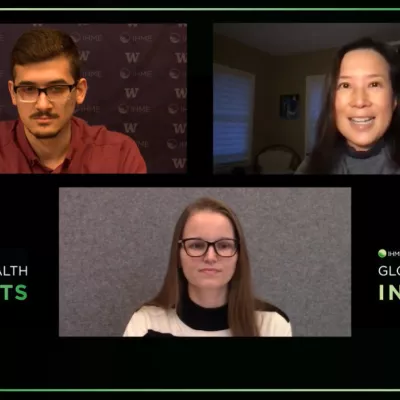Vaccine coverage
Vaccines are a powerful tool for saving lives and improving health, but their power can be diluted by gaps in coverage. We study routine childhood immunizations to understand and address these gaps.
Photo by Heather Hazzan for SELF magazine, Flickr.
Key findings
While great progress was made toward vaccine coverage in the 1990s and early 2000s, that progress has stagnated in recent years.
Rwanda has some of the highest rates of vaccine coverage in the African region.
With an average of 97.2% coverage for the third dose of the diphtheria, tetanus, and pertussis vaccine (DTP3), Rwanda stands out as a successful example of immunization programs at work.

The COVID-19 pandemic interrupted routine vaccinations for millions of children.
Research suggests that global coverage for the third vaccine dose against diphtheria, tetanus, and pertussis (DTP3) is showing uneven recovery from COVID-related disruptions to 81% in 2022, an increase from 79% in 2021.
Image source: Bill & Melinda Gates Foundation, 2023 Goalkeepers report.

Rates of measles vaccine coverage vary greatly within countries.
For example, in Nigeria, some states, like Ekiti, register over 80% vaccine coverage, while others are as low as 23%. Data at this precise, local level show where vaccination programs can have the greatest impact.
Our MCV Coverage data visual lets you explore local patterns of measles vaccine coverage for 100+ countries.
Why map vaccine coverage?
Work by IHME and others has demonstrated that global and national coverage levels of key, longstanding vaccines like diphtheria-tetanus-pertussis (DTP) and measles (MCV) were largely stagnant between 2010 and 2019 and even declined in many locations. At the end of 2019, more than 14 million children did not receive a single dose of DTP, and coverage inequities persist within countries.
Compounding these challenges, the COVID-19 pandemic has presented vaccine delivery programs around the world with new, unanticipated obstacles to ensuring that all children – including those historically missed by immunization programs – have access to the benefits of vaccines.
The Immunization Agenda 2030 (IA2030) highlights reaching “zero-dose” children (i.e., those who have never received a DTP dose) as an important facet of immunization goals, aiming to reduce the number of zero-dose children by 50% and bring country-level coverage of other key vaccines to within 5% of DTP1 coverage by 2030.
About our vaccine coverage work
We define vaccine coverage as the proportion of children who received at least the stated number of doses of each vaccine during the year that cohort was of the target age of vaccination. For example, DTP3 coverage in 2010 represents the proportion of children under age 12 months in 2010 who received at least three doses of a diphtheria-tetanus-pertussis-containing vaccine.
For our routine coverage estimates, we exclude campaign doses when possible. For some vaccines (e.g., measles), we additionally estimate age-specific vaccination coverage and combined coverage (from both routine immunization services and vaccination campaigns). When using survey data, we consider children to be vaccinated if they have valid doses recorded on a home-based record (“card doses”) or if their parents report that they have been vaccinated (“recall doses”).
We estimate multiple vaccines at the global, national, regional, and local levels in a comprehensive framework so all our estimates can be compared consistently between places and over time.
- Diphtheria-tetanus-pertussis (DTP)
- Measles-containing vaccines (MCV)
- Haemophilus influenzae type B (Hib)
- Rotavirus (Rota)
- Pneumococcal conjugate vaccine (PCV)
- Hepatitis B (HepB)
- Polio
- Rubella (RCV)
- Bacille Calmette-Guérin (BCG)
Our research methods are described in detail in our peer-reviewed scientific publications, which can be found in the research library.
Funding for this work was provided by the Bill & Melinda Gates Foundation and Gavi, the Vaccine Alliance.

